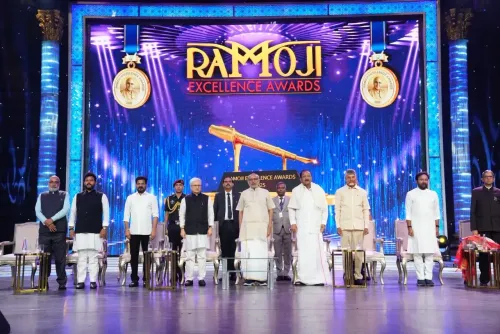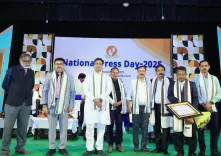How Do Bengal Women Bid Farewell to Maa Durga?

Synopsis
Key Takeaways
- The farewell to Maa Durga is both a worship and a familial tradition.
- Women celebrate Sindoor Khela as a symbol of unity and womanhood.
- Durga Puja rituals reflect the deep cultural roots of Bengali society.
- Community involvement is significant during the immersion process.
- The festival highlights the balance between reverence for the divine and familial ties.
Kolkata, Oct 2 (NationPress) At the start of this week, as the four-day Durga Puja commenced with Maha Saptami, Bengali women welcomed Maa Durga as a “goddess”, descending to Earth to vanquish evil forces.
However, just four days later, on Vijaya Dashami Thursday, these same women bid farewell to the beloved “Devi Durga”, this time as a “daughter at home,” returning to her in-laws for the year ahead.
The farewell rituals on Vijaya Dashami mirror those of a traditional Bengali family sending a young bride off to her in-laws the day after her marriage.
Scenes across various Puja pandals were similar. Women, predominantly dressed in vibrant red and white sarees, approached the Durga idols, first draping them with betel leaves, applying vermillion to their foreheads and cheeks, and finally placing sweetmeats on the idol's lips.
Once the rituals concluded, the women celebrated by smearing vermillion on each other’s foreheads and cheeks.
Monosree Banerjee, a 36-year-old resident of Lake Town, explained the significance of the ritual, stating that for Bengalis, Devi Durga represents not only a goddess who conquers evil but also a daugther who eventually returns to her in-laws.
“These four days of Durga Puja symbolize the return of the daughter to our homes from her in-laws. Now, she is going back for another year, and we bid her farewell through rituals where vermillion, a symbol for married women, plays a vital role,” she elaborated.
Supriya Mukherjee, 63, from Maheshtala, reminisced about her early days as a newlywed during the Vijaya Dashami rituals. “We anticipate this day all year. Although I am now a mother-in-law, the excitement remains unchanged. While there's a tinge of sadness today because we must wait another year, the Sindoor Khela symbolizes the return of our daughter Uma. Despite a recent family loss, we partake in this ritual to keep our traditions alive,” Mukherjee shared.
Keya Saha, 69, from Bowbazar, expressed that Sindoor Khela has evolved into an essential aspect of their culture. “What started as a ritual on Vijaya Dashami has transformed into a celebration of life and womanhood. The festival allows us to seek blessings from Ma Durga and share those blessings among peers. It’s a celebration of marriage, matriarchy, motherhood, and family values,” she stated.
Meanwhile, the immersion process began Tuesday afternoon at various Ganges ghats, lakes, and artificial water bodies across Kolkata, under strict security managed by Kolkata Police, the disaster management department, and the river traffic guard.
On Thursday, immersion activities were less crowded, as puja organizers from housing complexes and conservative community groups primarily opted for immersion on Vijaya Dashami.









